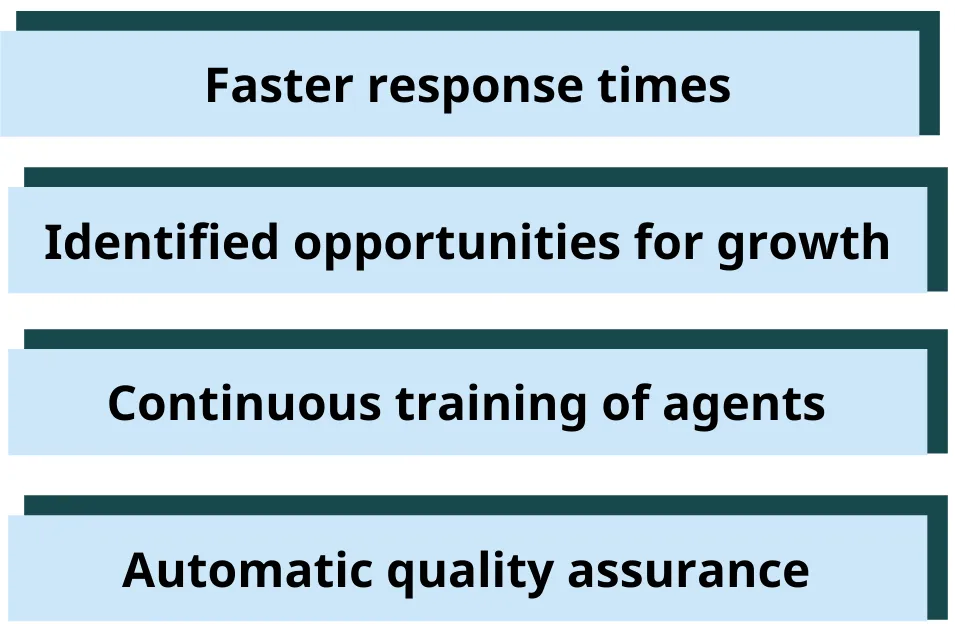You can listen to this article instead:
In the not-too-distant future, we’re convinced that businesses will consider customer service to be the most strategically useful business function.
The current state of the customer service industry
The current state of customer service, in so many companies, looks something like this:
- Customer acquisition is prioritised over retention
- Customer service investment projects are sidelined.
- Departmental efficiency is of highest priority.
- Businesses see employees in the customer service department as short-term and disposable. They are there to fulfil a specific, repetitive, purpose.
- Employees are considered unskilled and leaders hire accordingly.
- New agents view customer service as a ‘last resort’ or ‘short term’ job. People often see careers in customer support as unambitious.
- Agent training rarely goes beyond product and people skills.
This is just plain wrong. Customer service is a critical part of the customer’s experience.
When done right, customer service is already adding business value. Great customer service increases retention and repeat business despite the above.

Customer service in the future: the opportunity left on the table
Yet, this current state of customer service leaves opportunity on the table. The opportunity lies in the extraordinarily close relationship between agent and customer.
Talking to customers face to face, en masse, every day is unique to customer service.
Talking to customers face to face, en masse, every day is unique to customer service. That close contact is an untapped and unappreciated opportunity to build strong customer relationships, increase loyalty, hear customer feedback, improve products, build community, upsell, increase basket size, and so on.
More and more businesses are realising this opportunity. Forward thinking business leaders are already elevating the contact centre to strategic status and using it get an advantage over competitors.
We’ve already seen:
- Confident, wide-spread awareness that retention is just as important as acquiring new customers (if not more.)
- The use of customer support as a training ground for product, sales and marketing professionals. At Help Scout, agents earn deep product and customer knowledge in support and then join other teams.
- Injection of sales trained support agents into the customer journey at Schuh. The results were outstanding.
- In-store salespeople using free time to answer support queries at Three. Their ThreeStore Now project boosts sales and improves customer experience.
- Use of support conversations to measure product and feature performance.
- Use of insight from support conversations for root cause analysis.
- Rapid adoption of closed-loop and proactive customer support to tackle customer churn.
Driving real growth through support (like in the above examples) is far from standard and far from optimised.
This will change.
We opened with this statement: "businesses will consider customer service to be the most strategically useful business function". This is happening already and will only increase over the next 3-5 years.
The next 3-5 years
.webp)
In the next 3-5 years, we expect to see these future customer service trends:
- The shift from a primarily 'cost centre' to primarily 'growth centre' worldview.
- The job desc for a customer service director will focus more on leadership, innovation, and ability to drive company-wide improvement.
- Customer service will shift to become a strategic partner of marketing, sales, and product development. CS will help with direction, project prioritisation, and impact.
- A need for customer service leaders to take a highly strategic seat at the table. They’ll need to argue for investment in talent, technology, and innovation.
- A shift in performance metrics. Forget # of resolved tickets. In the future, we'll measure performance based on # of customers saved from the precipice of churn.
- A career in customer service will not be a last resort. Top graduates will prioritise getting an education in strategic customer interaction.
- Focus on ticket deflection will reduce because brands will view each customer interaction as an opportunity to learn, build a relationship, and grow profits. They deserve a well-trained, human touch.
Modern and developing technology enables this future to exist. With new technology, administrative tasks will tend toward zero.
Modern and developing technology enables this future to exist. With new technology, administrative tasks will tend toward zero.
Things humans do best (build relationships, empathise, make decisions, personalise) will be what humans do.
The impact of an overhaul in customer service
The best way to explain the impact of this is to split the customer service interaction into four layers and look at what’s important at each one.
The four layers are:
- Method of interaction. Important: Ease of interaction; communication channels enabled; location of interaction.
- Pre-interaction. Important: pre-informed agents; ticket prioritisation; ticket delegation.
- Interaction. Important: agent training in up/cross-sell opportunities; fast responses; responses in the way that’s most appreciated by the customer.
- Post-interaction. Important: Follow up; internal learning; future prevention.
Help desks cover most of the ‘method’ of interaction. New channels will continue to emerge, for example, social messengers are on the dramatic rise in customer support already. (See: Is WhatsApp the future of customer service?)
That trend will continue but your help desk should let you expand channels with ease.
Related read: 8 unique customer service improvement ideas that improve ROI
Customer service challenges of the future: how we get there
Granular, accurate, and real-time support ticket analytics is the lynchpin for much of what’s next for customer service.
Granular, accurate, and real-time support ticket analytics is the lynchpin for much of what’s next for customer service.
Advances in artificial intelligence have enabled the rapid synthesis of support ticket content. Our product at SentiSum now enables companies to know the topic and sentiment of every support request in real-time.
The application of AI to support tickets opens up a wealth of opportunity for strategic customer service.
Pre-interaction
In the pre-interaction stage, support ticket analytics will soon enable:
- Prioritisation of particularly angry customers
- Understanding of particularly painful topics that need extra attention
- Flagging of topics that cause nasty customer outcomes (e.g.churn)
- Support ticket delegation of tricky tickets to experienced agents

Interaction
In the interaction stage, support ticket analytics will soon enable:
- Faster response times
- Auto-identified opportunities for upsell or growth
- Continuous training of agents and automatic quality assurance

Related read: Best call center softwares for analytics and help desks in 2021
Post-interaction
In the post-interaction stage, support ticket analytics will soon enable customer service teams to:
- Identify points of customer friction before they become pain points (i.e. root cause analytics)
- Get alerted to unexpected trending issues to make sure they don’t affect more customers (i.e. issue prevention)
- Identify opportunities for product development
- Identify important training opportunities over time

Bringing it all together

In short, ticket analytics are the foundational layer that customer service needs to ‘become the most strategically useful business function’.
AI ticket analytics help customer service leaders deeply understand customers at scale, increase loyalty, drives growth and help the entire business to do the same.
Having mastered customer support ticket analytics with AI, we're one giant leap along the journey.
Our product roadmap is a series of steppingstones—each one takes customer support leaders step-by-step into this extraordinary future that awaits them.
If you’d like to learn how our clients use our support ticket analytics technology to get ahead, please book a demo with us today.
FAQs: Customer service in the future
What other trends are driving customer service?
Here are three important trends to take note of (other than AI-driven ticket insights):
- Real-time communication
We don't think chatbots fulfil a positive function. Usually, they're pretty frustrating to talk to and until they aren't, top companies will be hesitant to roll them out.
People, on the other hand, will always be critical to great customer service. The trend we expect to see continue is the fast availability of a real person to talk to.
Live chat software, self-serve content, queue-less phone calling will all be critical to customer retention in the future.
- Omnichannel customer support: connecting video, in-store, web browsing together
Some customers are digital savvy, some are not, some have strongly preferred communication methods, some don't mind.
With increasing complexity like this, it's critical to provide a seamless experience throughout the customer journey.
For example, you could inject video into the customer service experience,.Videos are a perfect match for millennials especially, and they make the customer support experience feel more intimate and real.
Here's two ways you get started:
Webinars
Webinars offer face-to-face, real-time content right to the mobile or laptop of your customer. Webinars can be used to reach customers en-mass. For example, if you had a critical issue (e.g. a global pandemic impacting delivery times) you could create one announcement webinar that all customers can attend, rather than calling your customer service team. On the other hand, you could use 1-to-1 video to increase basket size—like Schuh did in this story.
Video email
For a long time, email has been a vehicle for stellar client support. Take email to the next level with embedded video. Video emails have higher engagement, too!
You can deliver highly personalised and detailed communication right to an inbox. When you find yourself writing, “Sorry if this is too complicated,” consider a video email explaining the issue instead.
- Empowered Customer Service Representatives
Empowered agents are able to take action that helps the customer. Your customer service agents have a brain, trust them to use it because excessive escalations and inability to make minor decisions alone will kill your team's motivation and impact your customer.
Example 1: Each Virgin customer support agents can reach out directly to customers—and customers can reach out directly to them. Talk about customer care!
Example 2: Other companies give agents the go-ahead to offer solutions to problems without escalating issues. If a customer is angry on live chat, a real-time refund discount boosts customer satisfaction. Ritz-Carlton empowers reps to spend up to $2000 to make a customer happy.
Don't make customers wait while your rep has to ask someone else. And, definitely don't make the customer have to wait for the rep to follow up.
What are the 3 most important things in customer service?
We've done the analysis on this, so we know the answer.

The three most important things to a customer's overall customer service experience is: accessibility (could they get an agent on the phone), responsiveness (did an agent even respond?), empathetic (friendly, useful agents who get the problem resolved quickly).
What are the 3 elements of customer service that create brand advocates?
Here are three rules extracted from the article we wrote for LiveChat:
Rule 1: Seamless is expected
Customers hate the unexpected. Each industry has its own way of creating an unexpectedly negative customer experience, so you’ll have to work on identifying and tackling your own issues. For example, in the eCommerce furniture industry, customers frequently left vitriolic negative reviews if a piece of furniture arrived damaged (how disappointing) or broke within the first six months (what a waste of money).
In our original analysis, we saw similar in other industries. Food and recipe subscription boxes, for example, drive a ton of support tickets when an item is missing, damaged, or spoiled. Customers will come to the reviews to complain when this happens repeatedly. Once can be explained away, but more than once becomes unacceptable.
Food and recipe subscription companies like Mindful Chef, mentioned above, saw overwhelmingly positive reviews for food taste and quality. However, when you’ve planned a meal for the week and your food arrives mouldy or with an ingredient missing, it really throws a wrench into your plans. Brands should consider simplifying their offering if it’s hard to deliver while also remaining highly responsive to these churn-inducing issues in order to mitigate them.
Across fintech providers, we see a similar impact of the unexpected. Unexpected fees, frozen or blocked accounts, or the sudden inability to pay with a card all led to a severe reaction. More than 1,500 reviews mentioned a frozen or blocked account across the challenger banks we analyzed.
Rule 2: “Wow” your customer
You have the opportunity to “wow” a customer at every touchpoint. And, if you do, you’re sure to create widespread brand advocacy.
In the UK, when Monzo and Revolut grew their customer base rapidly, the “wow” factor was certainly a large contributor to their growth. Both banks provided a previously unseen level of transaction convenience, and the clarity on customers’ financial situation was wonderful because the banks let them know instantly when money is withdrawn from their account.
For Monzo (touchpoint map pictured below), app usability featured heavily in the reviews as did the ease of budgeting and other financial features. Instant notifications also drove positivity under the convenience theme.
Reviews left for food and recipe subscription boxes tell a similar story. People got the “wow” factor from the product taste and the ease of cooking, things they previously struggled to achieve. Usually, perfecting your core value proposition should create your “wow.” If you’re an online marketplace, like Amazon, your product won’t be it. Instead, your usability, prices, and delivery will be.
However, if you’re a product developer, you must uncover your “why.” In other words, what problem are you trying to solve? Doubling down on that differentiating factor by building both product experience and your marketing around it will help you develop brand clarity and penetrate the market faster.
In the eCommerce furniture market, we saw Wayfair perform particularly well when it came to packaging. Packaging quality was mentioned in nearly 2,000 reviews. On the other hand, MADE.com had just 100 reviews on that topic. Details like a well-packaged product create delight along the customer journey that clearly encourage customers to become brand advocates.
Rule 3: People love experiences that touch the senses
You’ve probably heard that in copywriting you shouldn’t focus on your features. Instead, you should focus on how life with your product will make your customer feel. Things like whether your customer will be happier, stress free, or have a higher status tend to create a bigger impact than the specific details of your product.
The data here very much confirms that. Across all industries we analyzed, the biggest drivers of positive sentiment were based on experience. In the food and recipe subscription box category, 67% of reviews focused on “meal experience.” Most prominently, taste, ease of cooking, variety, and health drove positive sentiment.
This shows that customers care most about how food and recipe boxes touch their senses. Brands should take note of this and focus their messaging on how much the customer will enjoy their meal, how easy cooking will become now, and how healthy they’ll feel with your recipes and food.
That’s a lesson for everyone trying to “wow” customers. This is further confirmed by ecommerce furniture customers who frequently mentioned (53% of reviews) the product experience. Reviews talked about “great packaging” and the “quality feel” of the material.
Brands often forget the small things, but the details that stimulate the customer are what really drive positive sentiment.
How does SentiSum fit into the future of customer service?
SentiSum is building AI technology that creates clarity in customer service.
Getting detailed insights from support tickets will allow customer support directors to know the top drivers of tickets, know which tickets are reducing profits, and understand easily how to solve problems facing customers.
SentiSum's platform is like Zendesk but insight. It brings every feedback and conversation channel together in one easy-to-use, simple-to-understand place.
For support leaders, this means reducing volume and contributing to the wider conversation about reducing churn.
For marketers, product managers, operations leaders, etc. it means getting as close to your customer as the frontline customer service agent is. Frontline insight, from the backline.
Heading 1
Heading 2
Heading 3
Heading 4
Heading 5
Heading 6
Lorem ipsum dolor sit amet, consectetur adipiscing elit, sed do eiusmod tempor incididunt ut labore et dolore magna aliqua. Ut enim ad minim veniam, quis nostrud exercitation ullamco laboris nisi ut aliquip ex ea commodo consequat. Duis aute irure dolor in reprehenderit in voluptate velit esse cillum dolore eu fugiat nulla pariatur.
Block quote
Ordered list
- Item 1
- Item 2
- Item 3
Unordered list
- Item A
- Item B
- Item C
Bold text
Emphasis
Superscript
Subscript

.webp)
.webp)






.png)

.webp)
.svg)











